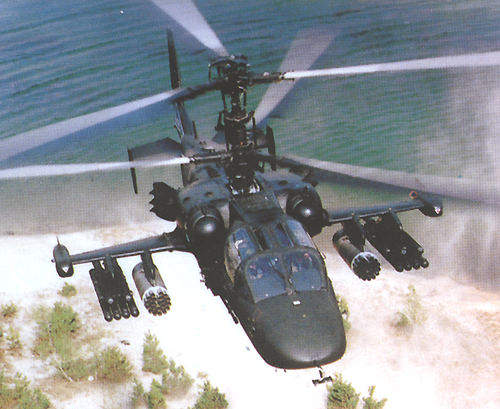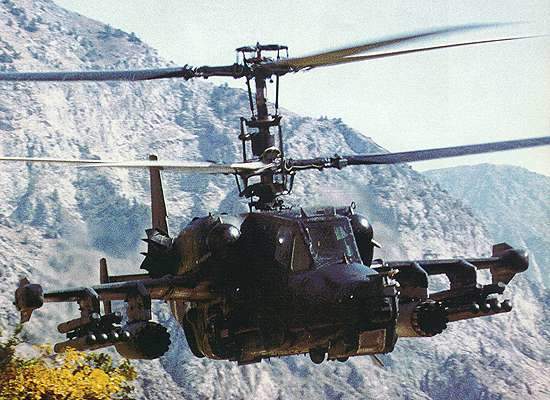In a pivotal moment in modern military aviation history, the Kamov Ka-50 Black Shark, Russia’s cutting-edge attack helicopter, embarked on its first combat mission. This event marked the operational debut of the world’s first single-seat coaxial rotor helicopter in a real-world combat environment. The mission, which took place in the rugged terrain of Chechnya during the Second Chechen War, demonstrated the Ka-50’s remarkable agility, firepower, and advanced avionics, solidifying its reputation as a formidable force on the battlefield.
Article: The Kamov Ka-50 Black Shark: Revolutionizing Attack Helicopter Warfare
The Kamov Ka-50 Black Shark, with its sleek design and fearsome reputation, is more than just a helicopter; it’s a symbol of Russian engineering prowess and military innovation. Developed during the closing years of the Cold War, the Ka-50 was envisioned as a game-changer in attack helicopter warfare. Today, its legacy continues to shape the future of rotorcraft combat.

The Birth of a Legend
The development of the Kamov Ka-50 began in the 1980s as the Soviet Union sought to create a new generation of attack helicopters that could dominate the battlefield. Unlike its Western counterparts, the Ka-50 was designed as a single-seat aircraft, a bold move that would maximize its agility and firepower. The helicopter’s coaxial rotor system, where two rotors are stacked one above the other and rotate in opposite directions, eliminated the need for a tail rotor. This unique design gave the Black Shark unparalleled maneuverability, allowing it to perform complex aerial maneuvers that traditional helicopters simply couldn’t match.
Combat Debut: The Mission that Changed Everything
The true test of any military aircraft is its performance in combat, and the Kamov Ka-50’s moment of truth came during the Second Chechen War in the late 1990s. Deployed in the mountainous and hostile terrain of Chechnya, the Ka-50 was tasked with providing close air support to Russian ground forces. Its first combat mission was a resounding success, showcasing the helicopter’s capabilities in a high-stakes environment.

On that fateful day, the Ka-50 demonstrated its superiority in several key areas. Its coaxial rotor system allowed it to hover in place for extended periods, providing a stable platform for precision strikes. Equipped with a 30mm 2A42 cannon and a variety of guided missiles, the Black Shark unleashed devastating firepower on enemy positions. Its advanced avionics and targeting systems enabled the pilot to engage multiple targets with lethal accuracy, even in poor visibility conditions.
The helicopter’s resilience was also put to the test. Despite taking enemy fire, the Ka-50’s armored cockpit and redundant systems ensured that the pilot remained safe and in control. This combat debut not only validated the Ka-50’s design but also sent a clear message to the world: Russia had developed a helicopter that could change the dynamics of modern warfare.
Technological Innovations
The Kamov Ka-50 wasn’t just another helicopter; it was a showcase of technological innovation. Its single-pilot configuration was supported by an advanced avionics suite that automated many of the tasks typically handled by a co-pilot. This allowed the pilot to focus on mission-critical decisions without being overwhelmed by the workload.
The helicopter’s weaponry was equally impressive. The Ka-50 could carry a mix of anti-tank guided missiles, rockets, and bombs, making it versatile enough to engage a wide range of targets. The integration of a sophisticated targeting system meant that the Black Shark could accurately strike targets while evading enemy defenses.

Another standout feature of the Ka-50 was its ability to operate in all-weather conditions, day or night. Its advanced sensors and night vision systems ensured that it could carry out missions in the most challenging environments, giving Russian forces a strategic advantage.
Legacy and Future Impact
The Kamov Ka-50 Black Shark’s successful deployment in combat solidified its place in the annals of military history. Although only a limited number were produced, the helicopter’s influence is undeniable. Its design and technological advancements have paved the way for the development of more sophisticated attack helicopters, including its successor, the Ka-52 Alligator.

Today, the Black Shark is revered not only for its combat prowess but also for the innovative spirit it represents. It remains a symbol of Russia’s determination to push the boundaries of military aviation and maintain its edge on the global stage.
As the world continues to evolve and new threats emerge, the lessons learned from the Kamov Ka-50’s development and deployment will undoubtedly shape the future of rotorcraft warfare. The Black Shark may have been born in the Cold War era, but its legacy will continue to influence the design and deployment of attack helicopters for generations to come.





